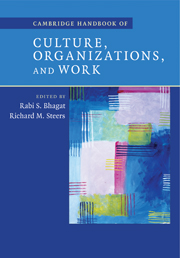Book contents
- Frontmatter
- Contents
- List of figures
- List of tables
- List of contributors
- Preface
- PART I CULTURAL FOUNDATIONS
- PART II CULTURE AND ORGANIZATION THEORY
- 4 Culture and organization design: strategy, structure, and decision-making
- 5 Cross-cultural perspectives on international mergers and acquisitions
- 6 Global culture and organizational processes
- 7 Cultural variations in the creation, diffusion and transfer of organizational knowledge
- 8 Cultural variations and the morphology of innovation
- PART III CULTURE AND ORGANIZATIONAL BEHAVIOR
- PART IV FUTURE DIRECTIONS IN THEORY AND RESEARCH
- Index
5 - Cross-cultural perspectives on international mergers and acquisitions
Published online by Cambridge University Press: 15 December 2009
- Frontmatter
- Contents
- List of figures
- List of tables
- List of contributors
- Preface
- PART I CULTURAL FOUNDATIONS
- PART II CULTURE AND ORGANIZATION THEORY
- 4 Culture and organization design: strategy, structure, and decision-making
- 5 Cross-cultural perspectives on international mergers and acquisitions
- 6 Global culture and organizational processes
- 7 Cultural variations in the creation, diffusion and transfer of organizational knowledge
- 8 Cultural variations and the morphology of innovation
- PART III CULTURE AND ORGANIZATIONAL BEHAVIOR
- PART IV FUTURE DIRECTIONS IN THEORY AND RESEARCH
- Index
Summary
Mergers and acquisitions (M&A) continue to be a highly popular strategy for achieving growth and diversification. The fastest growing type of M&A deal is the cross-border acquisition (Evans, Pucik, and Barsoux, 2002). Executives view cross-border acquisitions as an important strategy in extending their geographical reach and gaining rapid access to new markets and resources (datta and Puia, 1995). The ultimate driver of cross-border M&A activity is the increase in global competition and the corresponding erosion of national boundaries. Companies have followed their customers as they respond to the pressures of obtaining scale in a rapidly consolidating global economy. In combination with other trends, such as increased corporate restructuring, reduced trade barriers, easier access to global pools of capital, and access to new markets and specialized resources, globalization has spurred an unprecedented surge in cross-border M&A (Evans et al., 2002; Finkelstein, 1999; Shimizu, Hitt, vaidyanath, and Pisano, 2004).
However, despite their popularity and strategic importance, the track record of such transactions is not very encouraging. A meta-analysis by King, dalton, daily, and Covin (2004) of ninety-three published studies indicates that the post-acquisition performance of acquiring firms fails to surpass or tends to be slightly poorer than that of nonacquiring firms. This is consistent with previous research on M&A activity and financial performance that indicated that while the shareholders of target firms gain significantly from M&A, there is little evidence that value is created for the shareholders of acquiring firms (see datta, Pinches, and Narayanan, 1992; Lubatkin, 1983 for reviews). The King et al.
- Type
- Chapter
- Information
- Cambridge Handbook of Culture, Organizations, and Work , pp. 118 - 147Publisher: Cambridge University PressPrint publication year: 2009
- 3
- Cited by

